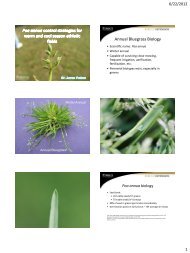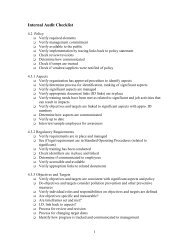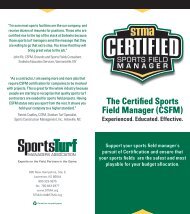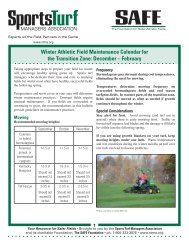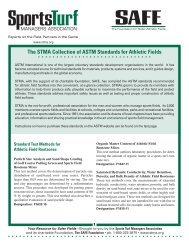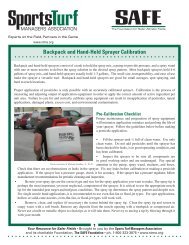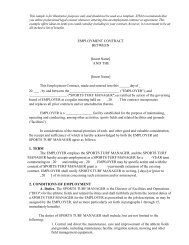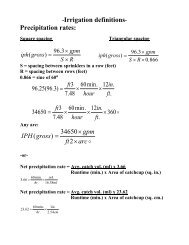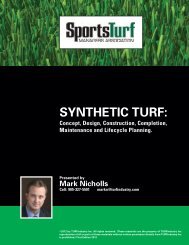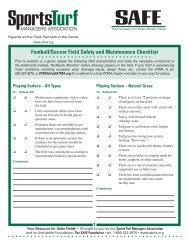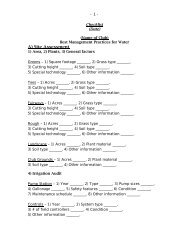Natural Grass Athletic Fields - STMA
Natural Grass Athletic Fields - STMA
Natural Grass Athletic Fields - STMA
You also want an ePaper? Increase the reach of your titles
YUMPU automatically turns print PDFs into web optimized ePapers that Google loves.
www.stma.org<br />
<strong>Natural</strong> <strong>Grass</strong> <strong>Athletic</strong> <strong>Fields</strong><br />
It is becoming more common that high schools and parks and recreation departments are<br />
replacing their natural grass playing surfaces with synthetic fields. The reason is often due to<br />
the belief that synthetic surfaces are less expensive and easier to maintain than natural surfaces.<br />
Synthetic is not an effective replacement if lower maintenance costs are the goal. In<br />
addition, it is not a solution to natural grass fields if they are being replaced for aesthetic reasons<br />
because they are worn out in the center at the end of the season. The following resource<br />
provides a detailed look into the benefits, disadvantages and cost effectiveness of maintaining<br />
natural grass fields for recreation.<br />
<strong>Natural</strong> <strong>Grass</strong> Benefits<br />
Environmental Benefits of <strong>Natural</strong> <strong>Grass</strong> Surfaces<br />
I. Water Conservation<br />
A major point of discussion with natural turfgrass systems is the amount of water required to irrigate. Most<br />
water overuse is due to human error or miscalculation. Understanding and following proper irrigation practices<br />
will lead to water conservation. Water conservation can also be achieved by:<br />
1. Using drought resistant turf cultivars.<br />
2. Allowing turf to enter dormancy in drought situations.<br />
3. Encouraging deeper rooting of turfgrass cultivars by watering deeply and infrequently.<br />
4. Using recycled water sources for irrigation.<br />
II. Groundwater and surface water quality preservation and improved recharge<br />
1. Dense above ground turf biomass traps and holds water which reduces excess runoff and allows more<br />
water to infiltrate into the soil.<br />
a. A research study in Maryland compared surface water runoff losses between turfgrass and cultivated<br />
tobacco grown at the same site. During the tobacco-growing season (May-September), surface water<br />
runoff losses for the tobacco were 11 times greater than runoff losses from perennial turf.<br />
2. Extensive, fibrous turfgrass root system filters water percolating through the soil to enhance groundwater<br />
recharge.<br />
3. Application of fertilizer has negligible potential for nutrient elements to pass through the rootzone into<br />
groundwater or be transported by runoff into surface water. Turfgrass roots are highly efficient at uptake<br />
of applied nutrients.<br />
a. A research study in Maryland followed total losses for nitrogen and phosphorus between turfgrass and<br />
cultivated tobacco grown at the same site. Runoff from the tobacco plantings had 195 times more N<br />
and 240 times more P than runoff from the turf.<br />
1<br />
Your Resource for Safer <strong>Athletic</strong> <strong>Fields</strong> • Brought to you by the Sports Turf Managers Association<br />
and its charitable Foundation, The SAFE Foundation. Ph. 1-800-323-3875
<strong>Natural</strong> <strong>Grass</strong> <strong>Athletic</strong> <strong>Fields</strong><br />
4. Proper fertilizer and pesticide applications keep water safe. Contamination of groundwater occurs with<br />
excessive overwatering, heavy rainfall events or when turf is dormant.<br />
5. Current trends with turf fertilization are toward low application rates and slow release nitrogen carriers.<br />
Both of these practices are more accepted and environmentally friendly.<br />
6. Turfgrass ecosystems support abundant earthworm populations, which contribute to increased spaces in<br />
the soil, resulting in higher soil water infiltration rates, higher water-holding capacity, and improved soil<br />
structure.<br />
III. Enhanced entrapment and biodegradation of synthetic organic compounds<br />
1. Turfgrass systems catch and filter polluted runoff water.<br />
2. Turfgrass leaves, crowns, stems, roots, thatch, soil, and soil microbes support large populations of<br />
microscopic decomposers. These decomposers break down pesticides and other noxious organic<br />
chemicals into harmless substances.<br />
IV. Soil erosion control and dust stabilization<br />
1. Turfgrass root systems and aboveground canopy are one of the most cost efficient ways to control water<br />
and wind erosion of soil and increase water infiltration into the soil.<br />
2. Turfgrass functions as a vegetative filter that reduces the quantity of sediment entering surface streams<br />
and rivers.<br />
3. High shoot density and root mass of turfgrass contributes to surface stabilization to reduce erosion. A<br />
high biomass matrix provides resistance to lateral surface water flow.<br />
4. Turfgrass acts as a trap for dust and other particulate matter to improve air quality.<br />
V. Atmospheric pollution control<br />
1. Turfgrass contributes to reductions in noise levels by absorbing, deflecting, reflecting, and refracting<br />
various sounds. There are also reductions in discomforting glare and light reflection.<br />
2. Turfgrass reduces atmospheric carbon dioxide and releases oxygen. <strong>Grass</strong> plants produce their own food<br />
through the process of photosynthesis. The plants take in carbon dioxide and convert it into simple<br />
sugars. As a result of photosynthesis and taking up of carbon dioxide, oxygen is released into the<br />
atmosphere.<br />
a. During an active growing season, 25 square feet of healthy turf will provide enough oxygen for one<br />
adult person for one day.<br />
VI. Accelerated restoration of disturbed soils<br />
1. Turfgrass improves soils through the addition of organic matter. As plant tissue dies, it is incorporated<br />
into the rootzone. This organic matter improves soil structure and provides nutrients to turfgrass<br />
systems.<br />
2. Soil restoration of environmentally damaged areas (i.e. burned-over land, garbage dumps, eroded rural<br />
landscapes, mining operations, and steep timber harvest areas) is accelerated when turfgrass is planted.<br />
VII. Substantial urban heat dissipation-temperature moderation<br />
1. Turfgrass dissipates high levels of radiant heat through the cooling process of transpiration.<br />
2
Synthetic Surface Temperature Case Study<br />
<strong>Natural</strong> <strong>Grass</strong> <strong>Athletic</strong> <strong>Fields</strong><br />
In spring 2002, Brigham Young University’s athletic department installed a synthetic surface on half of its football<br />
practice field. The other half is sand-based natural turf. Complaints about the heat of the synthetic surface prompted<br />
researchers to take temperature measurements and compare them with natural turf, bare soil, asphalt and concrete.<br />
They recorded temperatures at the surface and 2 inches below the surface.<br />
Temperatures of surfaces at BYU practice fields in June 2002. Average air temperature = 81.42°F<br />
Average surface temperature<br />
between 7:00 am and 7:00<br />
pm<br />
Average soil temperature<br />
between 7:00 am and 7:00<br />
PM (two inch depth)<br />
3<br />
Average temperature<br />
between 9:00 am and 2:00<br />
PM in the shade<br />
Average High Average High Average High<br />
Soccer (synthetic) 117.38°F 157°F 95.33°F 116°F<br />
Football (synthetic) 117.04°F 156°F 96.48°F 116.75°F 75.89°F 99°F<br />
<strong>Natural</strong> Turf 78.19°F 88.5°F 80.42°F 90.75°F 66.35°F 75°F<br />
Concrete 94.08°F<br />
Asphalt 109.62°F<br />
Bare Soil 98.23°F 90.08°F<br />
Source: “Synthetic Surface Heath Studies,” C. Frank Williams and Gilbert E. Pulley, Sports Turf Managers Association Annual Conference,<br />
January 2004.<br />
The surface of the synthetic field averaged 117 degrees Fahrenheit while the natural grass surface averaged 78<br />
degrees Fahrenheit and asphalt averaged 109 degrees Fahrenheit. Two inches below the synthetic turf surface, it was<br />
still 28 degrees hotter than the natural turf surface. Irrigation is installed on synthetic fields to help control surface<br />
temperatures. Researchers at Penn State University have found that temperature reductions last about 20 minutes.<br />
Researchers at BYU have found that irrigation cooled the synthetic surface from 174 degrees Fahrenheit to 85 degrees<br />
Fahrenheit, but during the summer in Utah, the surface could be back to 120 degrees Fahrenheit in five minutes.<br />
These high temperatures make it dangerous for athletes as it increases the incidence of heat stroke, muscle cramping<br />
and overall fatigue.<br />
VIII. Overall increase in human health<br />
1. Closely mown areas of turfgrass reduce the number of nuisance pests that reside in taller grasses, such as<br />
ticks, which can carry Lyme disease and Rocky Mountain Spotted Fever.<br />
2. Well maintained turf areas are less likely to have weeds that are responsible for allergy-related pollens.<br />
3. <strong>Fields</strong> with good quality turfgrass cover have higher traction, cushioning, and resiliency, and lower<br />
surface hardness, reducing the probability of injury in contact sports.<br />
a. Ball roll and bounce are influenced by the turf cover and its management, as are player movements,<br />
such as running, stopping, pivoting, dodging, jumping, landing, and walking.<br />
4. Turfgrasses can offer a low cost, safe playing surface for athletes.<br />
a. Surface hardness is important when considering head injuries. Surface hardness is expressed by the<br />
Gmax. A high Gmax indicates a hard surface. The limit for surface hardness on athletic fields is 200<br />
Gmax. This is considered to be the maximum threshold to provide an acceptable level of protection to<br />
users. At this point the surface should be repaired or replaced. Most synthetic fields have a Gmax of<br />
130 at installation. <strong>Natural</strong> grass fields typically stay between 80 and 140 Gmax depending on soil<br />
moisture and level of maintenance.
<strong>Natural</strong> <strong>Grass</strong> <strong>Athletic</strong> <strong>Fields</strong><br />
5. Aesthetics and recreational opportunities enhance physical and mental health of participants. <strong>Natural</strong><br />
grass areas relieve stress and contribute to enjoyment of life.<br />
a. Studies have been done to test the health benefits of nearby green spaces by testing blood pressure and<br />
heart rate of participants. Results show that views of open green spaces promote quicker recovery in<br />
hospital patients. Participants in another study had quicker and more complete recovery from induced<br />
stress when exposed to turfgrass and other landscape settings compared to those who were not.<br />
6. Native soil fields hold less potential for injury.<br />
a. The most frequent injuries sustained on sports fields are those to the ankles and knees from rotating<br />
and changing directions on the field surface. A recent study at Michigan State University measured<br />
the effects that size and structure of infill materials would have on the rotational resistance of cleated<br />
shoes. Sixteen different surfaces were tested, including native soil and sand based fields, using testing<br />
methods conformed to the ASTM standard method for traction characteristics of an athletic shoesurface<br />
interface. Cleated football shoes were mounted on a rigid footform and used on the surfaces.<br />
Results found that torque was significantly affected by field surface. Native soil fields reported the<br />
lowest torque overall.<br />
7. <strong>Natural</strong> fields are the preferred playing surface among athletes. In 2008, a survey was conducted to<br />
evaluate what kind of playing surface NFL players preferred. 1565 players from all 32 teams participated<br />
in this survey.<br />
• 71% of the players preferred to play on natural grass fields.<br />
• 15% preferred artificial infill.<br />
• 11% had no preference.<br />
Players were also asked how they thought synthetic and natural grass surfaces affected their physical health:<br />
4<br />
Artificial Infill Surface <strong>Natural</strong> <strong>Grass</strong> Surface<br />
Surface more likely to contribute to injury 84% 6%<br />
Surface more likely to cause soreness and fatigue 91% 7%<br />
Surface more likely to shorten career 92% 5%<br />
Surface more likely to negatively affect quality of life after football 61% 2%<br />
<strong>Natural</strong> <strong>Grass</strong> Limitations<br />
I. Overuse<br />
The overuse of many community sports facilities can push the limits of turf to recover. Excessive traffic leads to<br />
compaction and bare areas, which can cause a surface to be unsafe and unplayable. Scheduling more events than<br />
a field can handle results in overuse.<br />
To help prolong the life of natural fields:<br />
• Rotate activities between fields.<br />
• Limit use of fields to only necessary events.<br />
• Change daily location of practices on the field.<br />
• Use a portable goal and move it around the field, thus limiting wear in the area of the mounted goal posts.<br />
• Have players do individual warm-ups off of the field.<br />
• Execute team drills outside of painted numbers.<br />
• Spread seed in wear areas before games and practices.
II. Standing Water<br />
<strong>Natural</strong> <strong>Grass</strong> <strong>Athletic</strong> <strong>Fields</strong><br />
Inclement weather can lead to standing water and muddy conditions if the drainage system is not effective. This<br />
causes surfaces to be unsafe and unplayable.<br />
To solve standing water problems, make sure there is a sufficient crown to move water off the field effectively<br />
and check that the drainage systems operate efficiently. If rain tarps are available, they can help keep rain off<br />
the field to allow for playability.<br />
Costs<br />
Construction Costs of Synthetic and <strong>Natural</strong> <strong>Grass</strong> <strong>Fields</strong><br />
For a more complete understanding of what is involved with constructing a natural or synthetic field, please view<br />
the <strong>STMA</strong> Guide to Synthetic and <strong>Natural</strong> Turfgrass for Sports <strong>Fields</strong>.<br />
• <strong>Natural</strong> with On-site Native Soil (no added top soil or sod) - $0.90 - $1.50 per sq. ft.<br />
• <strong>Natural</strong> Turfgrass with Native Soils - $2.25-$5.25 per sq. ft.<br />
• <strong>Natural</strong> with Sand Cap - $4.00 - $6.50 per sq. ft.<br />
• <strong>Natural</strong> with Sand and Drainage - $7.00–$10.00 per sq. ft.<br />
• Synthetic Infill - $6.50-$11.00 per sq. ft.<br />
Annual Required Maintenance for <strong>Natural</strong> <strong>Grass</strong> and Synthetic <strong>Fields</strong><br />
<strong>Natural</strong> turfgrass fields:<br />
1. Mowing<br />
2. Fertilization<br />
3. Irrigation<br />
4. Aerification<br />
5. Topdressing<br />
6. Seeding<br />
7. Pesticides (herbicides, insecticides, fungicides)<br />
8. Line Painting<br />
9. Drainage Repair and Maintenance<br />
Long Term Maintenance for <strong>Natural</strong> <strong>Grass</strong> and Synthetic <strong>Fields</strong><br />
<strong>Natural</strong> turfgrass fields:<br />
1. Renovation<br />
2. Field Repairs<br />
5<br />
Synthetic fields:<br />
1. Additional infill<br />
2. Irrigation<br />
3. Chemical disinfectants<br />
4. Products to reduce static activity and odors<br />
5. Drainage repair and maintenance<br />
6. Erasing and repainting temporary lines<br />
7. Removing organic matter accumulation<br />
8. Grooming<br />
Synthetic fields:<br />
1. Repairs (seams)<br />
2. Replacement is needed every 8 to 10 years.<br />
3. Disposal cost upon replacement. Infill systems<br />
are filled and topdressed with crumb rubber<br />
material that is typically made from ground<br />
automobile tires and may require special<br />
disposal. These disposal costs are estimated<br />
to be $130,000 plus transportation and<br />
landfill charges.
<strong>Natural</strong> <strong>Grass</strong> <strong>Athletic</strong> <strong>Fields</strong><br />
Maintenance Comparison Case Studies between <strong>Natural</strong> <strong>Grass</strong> <strong>Fields</strong> at North Scott Community<br />
School District and a Synthetic Field at Michigan State University<br />
Disclaimer: Maintenance, material and labor costs are highly variable depending on region of the country<br />
and type of facility. The following costs are based off of fields at North Scott Community School District and<br />
Michigan State University, and are meant to provide a realistic representation for costs involved with building<br />
and maintaining athletic fields.<br />
<strong>Natural</strong> – North Scott Community School District<br />
North Scott Community School District is located in Eldridge, Iowa. School grounds and sports turf requiring<br />
maintenance totals 115 acres. The District maintains a native soil baseball field, softball field, and 214,000<br />
square feet of native soil practice fields. The school also has a football stadium field with a 4 inch sand cap and<br />
a new, sand based soccer field built to USGA specifications. All of the grounds maintenance is done in house by<br />
three full time and three summer seasonal staff members. John Netwal, CGCS, is the Director of Operations for<br />
North Scott Community School District and has provided the following information.<br />
<strong>Natural</strong> Turf Maintenance Equipment<br />
Tractor-mount sprayer $700<br />
Utility tractor $15,000<br />
Front end loader attachment for utility tractor $4,000<br />
Broadcast spreader $400-$1,200<br />
Rotary-motion aerator attachment for tractor $6,300<br />
Drag mat $300<br />
Topdresser $7,000<br />
Field painting equipment $8,400<br />
Work Cart $4,500<br />
Reel Mower $3,500-$22,000<br />
Rotary Mower $22,000-$35,000<br />
Trimmers $250-$600<br />
Seeder $250<br />
Total $72,600-$105,250<br />
6
<strong>Natural</strong> <strong>Grass</strong> <strong>Athletic</strong> <strong>Fields</strong><br />
2009 Native Soil Practice Area Field Maintenance Cost Estimates<br />
Total Area: 214,000 square feet<br />
Description of Activity Man Hours<br />
7<br />
Man Hour<br />
Cost<br />
Product<br />
Product<br />
Cost<br />
Total<br />
Activity<br />
Cost<br />
33 Mowings / Season 97 1,912.84 1,912.84<br />
Aeration, 5 times per year 45 887.40 887.40<br />
Fertilizer @ 4.9 #s N / year 14 276.08 Fertilizer 2,295.00 2,571.08<br />
Soil Amendments 3 59.16 Gypsum 551.04 610.20<br />
Herbicide Applications 3 59.16 Herbicide 45.32 104.48<br />
Pre-emergent<br />
Spot Spray Round-Up, 1 Time / Month Round-Up<br />
10 Game Field Prep’s, Soccer 15 295.80 Paint 1,060.50 1,356.30<br />
16 Practice Field Prep’s, Football 45 887.40 Paint 610.10 1,497.50<br />
Overseeding 8 157.76 Seed 1,710.00 1,867.76<br />
Growth Regulator, Apr, May, Jun, Jul, Aug 16 315.52 Primo 2,324.10 2,639.62<br />
Pre-emergent Applications<br />
Insecticide Applications Dylox<br />
Water, 1 Acre Inch Per Week 10 197.20 Water 9,213.00 9,410.20<br />
Miscellaneous $25 / Month 10 197.20 Supplies 200.00 397.20<br />
Totals $5,245.52 $18,009.06 $23,254.58<br />
Labor Cost: $16.44 x 20% benefits = $19.72 per hour<br />
Bottom Line: North Scott Community School District’s native soil practice fields (214,000 square feet) cost<br />
$23,254.58 per year to maintain. One native soil football practice field (57,600 square feet) costs $6,045 per<br />
year to maintain.
<strong>Natural</strong> <strong>Grass</strong> <strong>Athletic</strong> <strong>Fields</strong><br />
2009 Football Stadium Field Maintenance Cost Estimates<br />
Football field has 4 inch sand cap<br />
Total Area: 70,000 square feet<br />
Description of Activity Man Hours Man Hour<br />
Cost<br />
8<br />
Product Product<br />
Cost<br />
Total<br />
Activity<br />
Cost<br />
33 Mowings / Season 50 986.00 $986.00<br />
Aeration, 3 Times Per Year 15 295.80 Verti-Drain $295.80<br />
Sod Replacement Sidelines 12 720.00 Sod 1,000.00 $1,720.00<br />
Fertilizer @ 4.9 #s M / year 8 157.76 Fertilizer 810.00 $967.76<br />
Soil Amendments 1 19.72 Gypsum 183.68 $203.40<br />
Herbicide Applications 1 19.72 Herbicide 14.28 $34.00<br />
Pre-emergent Applications<br />
Growth Regulator (Apr, May, Jun, Jul, Aug) 5 98.60 Primo 762.60 $861.20<br />
Game Field Prep’s 60 1,183.20 Paint 378.75 $1,561.95<br />
Over-Seeding 15 295.80 Seed 570.00 $865.80<br />
Insecticide Applications Dylox<br />
Water, 1 Acre Inch Per Week 10 197.20 Water 4,784.34 $4,981.54<br />
Miscellaneous, $25.00 / Month 30 591.60 Supplies 200.00 $791.60<br />
Stadium Preps 18 354.96 $354.96<br />
Sports Lighting, 15 events @ 4 hours in<br />
length / season<br />
Electricity 373.76 $373.76<br />
Totals $4,920.36 $9,077.41 $13,997.77<br />
Labor Cost: $16.44 x 20% benefits = $19.72 per hour<br />
Bottom Line: North Scott Community School District’s sand capped football stadium field costs $13,997.77<br />
per year to maintain.
<strong>Natural</strong> <strong>Grass</strong> <strong>Athletic</strong> <strong>Fields</strong><br />
2009 Sand Based Soccer Field Maintenance Cost Estimates<br />
Total Area: 114,000 square feet<br />
Description of Activity Man Hours Man Hour Cost Product Product Cost Total Activity<br />
Cost<br />
50 Mowings / Season 113 2,228.36 $2,228.36<br />
Growth Regulator, Once Per<br />
Month<br />
Topdressing, 5 Applications<br />
Per Year<br />
Water, 1 Acre Inch Per<br />
Week / 26 Weeks<br />
12 236.64 Primo 1,227.60 $1,464.24<br />
31.5 621.18 Sand 1,987.50 $2,608.68<br />
6 118.32 City Water 5,440.50 $5,558.82<br />
Fertilizer @ 6.1 #s N / Year 12 236.64 Fertilizers 1,548.00 $1,784.64<br />
Paint, 6 Applications Per<br />
Season / 20-5 Gallon Pails<br />
45 887.40 Paint 378.75 $1,266.15<br />
Aeration, 3 Times Per Year 13.5 266.22 Verti-Drain $266.22<br />
Fungicide, Four Applications<br />
/ Season<br />
Over-Seeding, Once Per<br />
Season<br />
Herbicide, One Application<br />
Per Season<br />
Fence-line Maintenance, 2<br />
Apps. Per Year<br />
8 157.76 Disarm 480 SC 1,575.00 $1,732.76<br />
5 98.60 Seed 997.50 $1,096.10<br />
2 39.44 Herbicide 22.66 $62.10<br />
8 157.76 Control Products 125.00 $282.76<br />
Miscellaneous 50 986.00 Misc. Products 200.00 $1,186.00<br />
Pre-emergent Applications 4 78.88 Drive 75 DF 360.18 $439.06<br />
Insecticide Applications Dylox<br />
Sports Lighting, 10 events<br />
@ 3 hrs in length per<br />
season<br />
9<br />
Electricity 402.60 $402.60<br />
Totals $6,113.20 $14,265.29 $20,378.49<br />
Labor Cost: $16.44 x 20% benefits = $19.72 per hour<br />
Bottom Line: North Scott Community School District’s sand based soccer field costs $20,378.49 per year to<br />
maintain.
Synthetic – Michigan State University<br />
Outside Contractor Maintenance Charges<br />
<strong>Natural</strong> <strong>Grass</strong> <strong>Athletic</strong> <strong>Fields</strong><br />
Consultation and/or training $1,200-$3,000 per day plus expenses<br />
Repairs $30-$70 per linear foot<br />
Crumb Rubber $.50-$1.00 per pound applied<br />
Synthetic Turf Maintenance Equipment<br />
Boom Sprayer $1,000-$35,000<br />
Sweeper $1,500-$20,000<br />
Broom $500-$3,000<br />
Painter $500-$3,000<br />
Groomer $1,500-$2,000<br />
Cart (to tow equipment) $2,500-$16,000<br />
Field Magnet $500-$1,000<br />
Rollers $250-$2,000<br />
Total $8,250-82,000<br />
10
<strong>Natural</strong> <strong>Grass</strong> <strong>Athletic</strong> <strong>Fields</strong><br />
2004-2005 Maintenance Budget for Synthetic Infill Field with a three year old surface<br />
Seam Repairs (outside contractor; $30 per linear foot) $8,000<br />
Apply Crumb Rubber<br />
(1 time per year; 20 hours per application; 10 tons of topdressing at $500 per ton) $5,000<br />
Spray Field<br />
(4 times per year; 3.5 oz rate per 1000 square feet; 3 hours each; 12 hours per year) $216<br />
Fabric softener at $7 per 64 oz container $120<br />
Disinfectant at $5 per gallon $100<br />
Sweep Field<br />
(Parker Sweeper; 4 times per year; 8 hours each; 32 hours per year) $1,500<br />
Broom $500<br />
Groomer $2,800<br />
Hand Pick<br />
(3 times per week; 1 hour each; 156 hours per year at $18 per hour) $2,800<br />
Paint Field<br />
(2 times per year; 30 hours each; 60 hours per year; 30-40 gallons per year at $25 per<br />
gallon) $1,000<br />
Total Straight Hourly Cost<br />
(Field only; 280 hours at $18 per hour; benefits not included) $5,040<br />
Total Supply Cost $6,220<br />
Total Equipment Cost $3,500<br />
Total Outside Contractor Repairs $8,000<br />
Total Maintenance Cost 2004-2005 $22,760<br />
Bottom Line: Michigan State University synthetic field costs $22,760 per year to maintain.<br />
11
Next Steps<br />
<strong>Natural</strong> <strong>Grass</strong> <strong>Athletic</strong> <strong>Fields</strong><br />
To advocate the construction of a natural turf surface or improve the quality of the current natural grass field:<br />
• Involve your <strong>STMA</strong> Sports Turf Manager in decisions and gathering of information and costs.<br />
If you do not already have a sports turf manager for your facility, it is important to have a qualified<br />
professional who can be involved in decisions and gathering of information and costs.<br />
If constructing a field, your sports turf manager can serve as a grow-in consultant to work with the<br />
architect and contractors to oversee the entire construction process.<br />
On a daily basis, your sports turf manager can oversee the care of the athletic fields, maintain the<br />
budget, manage staff, and communicate with users.<br />
Investing in your sports turf manager is important in keeping them current on industry trends and<br />
research. Make sure your sports field manager is involved with <strong>STMA</strong> for networking and continuing<br />
education opportunities. <strong>STMA</strong> also provides the opportunity to become certified. Certified Sports<br />
Field Managers (CSFMs) are recognized in the industry for continuing to improve professionally.<br />
• Organize a meeting to educate community, coaches, administration, athletes, and parents about the<br />
benefits of a natural turfgrass athletic field.<br />
• Define resources needed to maintain a quality surface for your facility.<br />
• Develop a budget.<br />
• If constructing a field, meet with architects and contractors to find the best price option.<br />
• Schedule meetings to keep those involved updated on progress.<br />
• Form committees to assist in logistics and fundraising.<br />
<strong>Natural</strong> <strong>Grass</strong> <strong>Fields</strong><br />
The environmental and human health benefits alone make natural grass fields a desirable option when<br />
considering keeping or building a high school athletic field. The cost effectiveness of construction and annual<br />
maintenance only add to their appeal. It is important to have a complete understanding of the costs and benefits<br />
associated with both natural and synthetic surfaces when considering converting from natural grass to a<br />
synthetic surface. Often times many of the benefits of natural grass systems are overlooked because of strong<br />
arguments and marketing efforts of synthetic turf companies.<br />
12
References:<br />
<strong>Natural</strong> <strong>Grass</strong> <strong>Athletic</strong> <strong>Fields</strong><br />
Aaron Patton, Ph.D., University of Arkansas: Synthetic (Artificial) Turf vs. <strong>Natural</strong> <strong>Grass</strong> <strong>Athletic</strong> <strong>Fields</strong><br />
http://turf.uark.edu/turfhelp/archives/021109.html<br />
Andrew McNitt, Ph.D., Penn State University: Evaluation of Playing Surface Characteristics of Various In-Filled Systems<br />
http://cropsoil.psu.edu/mcnitt/infill.cfm<br />
<strong>Athletic</strong> Turf News: Experts spell out the true cost of synthetic turf maintenance<br />
http://www.superbowlsod.com/pdfs/real3.pdf<br />
<strong>Athletic</strong> Turf News: Infill systems spark debate at <strong>STMA</strong> conference<br />
http://www.athleticturf.net/athleticturf/content/printContentPopup.jsp?id=85955<br />
<strong>Athletic</strong> Turf News: <strong>Natural</strong> turf or synthetic turf: The numbers game<br />
http://www.athleticturf.net/athleticturf/article/articleDetail.jsp?id=151825<br />
A Review of the Potential Health and Safety Risks from Synthetic Turf <strong>Fields</strong> Containing Crumb Rubber Infill: New York City Department of<br />
Health and Mental Hygiene<br />
http://www.stma.org/_files/_items/stma-mr-tab1-2637/docs/new%20york%20city%20turf_report_05-08.pdf<br />
James B. Beard and Robert L. Green: The Role of Turfgrasses in Environmental Protection and Their Benefits to Humans<br />
http://superbowlsod.com/pdfs/real2.pdf<br />
University of Minnesota: Environmental Benefits of a Healthy, Sustainable Lawn<br />
http://www.sustland.umn.edu/maint/benefits.htm<br />
University of California: Turf Protects the Environment, Benefits Health<br />
http://ucrturf.ucr.edu/topics/turfprotects.htm<br />
John Netwal, CGCS, North Scott Community School District: Practical Recordkeeping for the Sports Turf Manager<br />
Mark Villwock, Eric Meyer, John Powell, Amy Fouty, and Roget Haut: Michigan State University: Football Playing Surface Components May<br />
Affect Lower Extremity Injury Risk<br />
http://www.x-cdtech.com/nacob/Abstracts/37.pdf<br />
13



